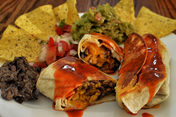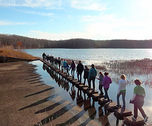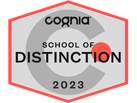IDEAVENTIONS ACADEMY
 Pizza Friday, Taco Tuesday, Breakfast for Lunch. Yum… Those were the words that came to mind when I thought about the school lunch program. When planning the school, we knew we wanted to have lunch included to make it easier on parents. We also knew that we wanted the food to be healthy and tasty. Tasty is easy, who wants to eat food that doesn’t taste good? Healthy, what does that mean? Being parents ourselves, we have spent countless hours making lunch in the morning or the night before and struggling on how to make sure our children get (and eat!) their veggies. I also know that when I eat well, and by well, I mean healthy, I feel better. It’s easier for me to think, I feel sharper, and I have more energy. Shouldn’t we want that for our kids? I can also see what happens to my kids when they have a bag of M&Ms or when we travel and eat out for a week, how our behavior changes. Therefore, it was easy to decide that the food that would be served at the Academy would be held to the same standard as the food that I feed my family: organic food for the Dirty Dozen, food that is responsibly farmed, humanely raised, meats from animals that have not been treated with antibiotics or hormones, and cooking that does not add preservatives or artificial colors. How do you implement a school lunch program that meets the “healthy” criteria and that’s tasty? We were lucky to find a caterer that does school lunches whose philosophy mirrors ours. Lokl Gourmet, a local caterer referred to us by a parent, believes in knowing your food, which is a great way to describe a philosophy around food. After meeting the owners and learning about their program, they added a criteria that we had not thought about - locally sourced where possible. Then, we were presented with a sample menu. What can I say? It was exactly what we had been looking for and even more. The selection and variety is better than what we could have imagined. The final step in the process was the taste test. The kids who were in town last weekend got together for a social at Gadsby’s Tavern. At this event, the team from Lokl Gourmet brought some samples for kids to try. The result? An overwhelming success. They liked the food! We are thrilled to have found a partner in our school lunch program that shares our philosophy and is able to provide the type of school lunch that rivals (and surpasses!) mom’s healthy dinners. I’m going to have to step up my dinner game. There will be a two week hiatus on the Teaching Tuesday. We will return on August 18.
0 Comments
 Our philosophy on Humanities is a logical follow-on to last week’s topic of travel. When I travel, I experience the culture of the country, or even the city or state. However, the culture of the people that I am visiting has been influenced or formed by their history. Having an understanding of that history allows us to have a deeper appreciation for the people and places we visit. With this in mind, one of our biggest concerns as we planned the curriculum for the Academy was the Humanities. It’s not a concern for the kids who enjoy both STEM and the liberal arts. But it was a concern for those kids who are your really STEMmy kids, the ones who haven’t liked social studies or history so far. The reason to study history is beautifully explained by Peter Stearns in Why Study History for the American Historical Association so I won’t repeat it. Rather, I will focus on the approach to make history and social studies an enjoyable subject for all. Our approach is to first present the story to the kids, in essence, what’s the plot. This will give them the context for the next level of work. Next, we want them to learn to analyze what they read or observe, so that they can draw their own conclusions. Lastly, we use the information that we have learned and critical thinking skills to understand recurring themes throughout history, such as power, leadership, or immigration. Therefore, we set out to make the Humanities class something that they would enjoy, or at the very least, appreciate. Our goal is to make the story of the world, sometimes a beautiful story, sometimes a tragic story and sometimes a frightening story, come alive for the kids Because we live in the United States, we believe it’s important to understand the history and culture of the country that we live in. We also believe it’s important to understand the history of the world we live in. That’s why our 4th and 5th grade sequence focuses on learning the context and story of the United States and the world. To make the story of the world meaningful to the younger grades, we look at history through the eyes of math and science, and tie what we are learning in our other classes with history. This also gives us a very interesting perspective since different cultures and civilizations have experienced periods of scientific or technological advancement at different times. Once in the traditional middle-school grades, 6th to 8th grades, we move to a more analytical class. We present primary and secondary sources where students learn to think like historians, analyzing the context and bias and drawing conclusions from what they are analyzing. Instead of studying the history chronologically, they now examine themes and the relationships between different events or periods of time in history surrounding that theme. Finally, students learn about the United States government and international governmental organizations and laws so that they are able to understand current events. In order to bring it alive, we use a multitude of media. The obvious one is that we read, but we also watch videos, we create projects, we film a documentary, we engage in debate, we question historical reenactors, we role play, and finally, we travel. Surprisingly, the ways to learn about history in a creative and “hands-on” way are endless.  I remember being a foreign exchange student France on Bastille Day 23 years ago and the amount of learning I experienced that summer. Perfecting a foreign language, living the culture, watching Francois Mitterrand on television with my host family and traveling around the country, I learned so much more in those 8 weeks in Europe than I had in two years of classroom French. Now, I was able to better appreciate everything I had experienced because of the four years of French I had studied and that brings me to today’s topic - Experiential Learning, otherwise known as Field Trips. Part of our teaching philosophy is that we should have an experiential learning experience monthly. These experiences can range from seeing a play on a topic we’re studying, to digging for fossils or visiting an historical location. Students should have an opportunity to get out of the classroom and see the country and the world. We believe students should be able to take what they have learned in the classroom and experience it in real life. With time being one of the most scarce resources for any classroom teacher, taking children out of school for these experiences should be planned carefully so that the experience means something and reinforces what the students have been learning in class. And with money being the other scarce resource for schools, the financial investment should have a return. Having the background, the history, the context turns a simple outing into an experience. Imagine walking around Westminster Abbey and not recognizing the names Charles Darwin or Isaac Newton, it probably looks like another beautiful church in Europe. Next, imagine walking around Westminster Abbey with an understanding of the people who have contributed to history, literature and science. All of the sudden, this beautiful church takes on a different level of significance. The context and preparatory learning are needed to appreciate and learn from the experience. In planning this coming year’s trips, what I have found is that there are so many places we want to take the kids and so little time. Therefore, we are choosing the best trips to support what we’re learning in school in the different subjects as we view it as another learning modality. In an ideal world, the week would be eight-days long, with five days in school, one day out in the field and two days off for rest. In addition to day trips, we believe in the value of overnight trips. These trips are wonderful because we’re able to work on social and emotional skills, which, along with academics, form the three-legged stool that is school. Travel can be an intimidating experience. Eating new foods, visiting new places, and interacting with our school friends all day AND all evening provides many informal learning opportunities on social skills, resilience, flexibility and manners. What we hope children gain from traveling as part of a school group is a better appreciation for the world we live in, that they internalize what they have learned in school and that they gain confidence in themselves.  I love reading. I love reading fiction, non-fiction, periodicals. I love reading books, newspapers and on my Kindle. You name it, I love reading it. Reading is a form of travel. When engrossed in a book, the reader travels to other times, to alternate worlds or other countries. Reading is also lifelong learning. Think to your college experience. Yes, there were classes, seminars and problem sets, but there was also a lot of reading. Building the Library at Ideaventions Academy has been one of the most pleasurable experiences of this journey as I think about sharing this passion for reading and learning with our students. Core Ideas When I read about Nancie Atwell winning the Global Teacher Prize, her story struck a chord with me. We knew we wanted a library and had ideas on how to build it, but after reading one of her books, The Reading Zone, the ideas that we’d been talking about crystallized into an action plan. Choice One of the main ideas behind her teaching philosophy is Choice. Her students have a choice in books to read. They have a choice to not finish a book. The goal is for students to experience “the zone” in reading. Children are seldom given the opportunity to choose and there is so much power in being given a choice of what to read that helps one develop a love for reading. The role of the teacher is to get to know the child and what that child likes in order to facilitate finding a book that the child will enjoy. Challenge Level I love the categorization of Holidays, Just Rights and Challenges. Holidays are the easy-reads. They’re the comfortable blanket that you may go back to. Reading Holidays every once in a while is great as it develops confidence.. Just Rights are books that introduce some new vocabulary, but are Just Right for the child at his or her current development. These are the types of books that the child should be spending most of his or her time reading. Finally, the Challenges. These are the books that a child may want to read now, but it’s difficult to do so independently. It could be the vocabulary or the plot, or the sentence structure that makes it too difficult for the child to read alone, but it provides good exposure when read with help of an adult. Sharing The concept of booktalking is phenomenal. How many times did you struggle as a child to write the 2-page, single-space book report on a book that you did not like? Book talks are language arts with a purpose! The purpose is to share and communicate about a book that the child feels strongly about. Our Plan Reading Workshop is part of the Humanities curriculum and reading is the only assigned daily homework students will have. In order to have books to read, students need a library. I’ve shared the philosophy, but I’d like to share the implementation plan and logistics that will allow us to make that a reality. Building the Library To build the library:
Organizing and Using the Library We’ll be organizing the library based on genre with a section reserved for recommended books by the students. We’re working on implementing a simple check-out process so that we’re able to track the books. Location We’ve decided that non-fiction books will be housed with the subject teacher. For example, chemistry books will be in the Chem Lab, engineering books in the Engineering Lab and History books in the Humanities Classroom. Fiction books will be housed in the school library. And of course a few bean bags are in order. We can’t wait to see the kids actually using the library! |
AuthorJuliana Heitz is co-founder of Ideaventions Academy and is very excited to share the thinking behind the Academy. Archives
October 2023
Categories |
Copyright © 2010-2024| 12340 Pinecrest Road, Reston, Virginia 20191 | 703-860-0211 | [email protected] | Tax ID 27-2420631 | CEEB Code 470033
 RSS Feed
RSS Feed




